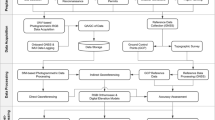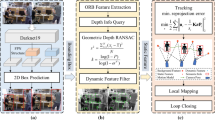Abstract
Background
The widespread use of large-space structures has led to a subsequent increase in the demand for the inspection and monitoring of engineering structures. Digital construction of engineering structures poses a challenge to conventional measurement methods. The development of noncontact measurement methods based on computer vision and photogrammetry technologies has made these measurements possible.
Objective
In this study, cable tension and progressive collapse processes of suspen-dome structure were investigated using unmanned aerial vehicle (UAV)-assisted close-range photogrammetry and multi-camera stereo-digital image correlation (stereo-DIC).
Methods
Based on the principles of close-range photogrammetry, three-dimensional (3D) points reconstructed by a digital single-lens reflex (DSLR) camera and camera mounted on UAV are registered, and the global coordinate system is established. In the cable tension process, a stereo-DIC system enhanced by parallel computing was used to monitor the displacement of the local structure in real time, and the tension process was accurately controlled using real-time monitoring data. The UAV was then used to measure the whole-field static displacement of the upper control points after tension. Finally, the progressive collapse displacement monitoring of the structure is realized by a multi-camera stereo-DIC system comprising 12 high-speed cameras, and the coordinate system of the 12 subsystems is unified to the established global coordinate system.
Results
The results indicate that the displacement sensitivity of a multi-camera stereo-DIC system is higher than 0.05 mm. The measurement results show that the structure meets the design index after tension. The static displacement of the nodes before and after tension can be measured accurately based on the UAV and close-range photogrammetry, which directly reflects the overall deformation trend of the structure after tension. The collapse test results indicate that the structure collapsed quickly after slow deformation for approximately 2.5 s.
Conclusions
The UAV-assisted close-range photogrammetry and multi-camera stereo-DIC system accurately captured the 3D displacement data of both cable tension and progressive collapse processes. The accurate measurement of these data has a great value for engineering applications, model tests, and numerical analysis.






















Similar content being viewed by others
Data Availability
The data that support the findings of this study are available from the corresponding author upon reasonable request.
References
Ngeljaratan L, Moustafa MA, Pekcan G (2021) A compressive sensing method for processing and improving vision-based target-tracking signals for structural health monitoring. Comput Aided Civ Inf Eng 36(9):1203–1223
Weng Y, Shan J, Lu Z, Lu X, Spencer BF Jr (2021) Homography-based structural displacement measurement for large structures using unmanned aerial vehicles. Comput Aided Civ Inf Eng 36(9):1114–1128
Tian Y, Zhang J, Yu S (2019) Rapid impact testing and system identification of footbridges using particle image velocimetry. Comput Aided Civ Inf Eng 34(2):130–145
StöCker C, Eltner A, Karrasch P (2015) Measuring gullies by synergetic application of uav and close range photogrammetry — A case study from andalusia, spain. CATENA 132:1–11
Luhmann T (2010) Close range photogrammetry for industrial applications. ISPRS J Photogramm Remote Sens 65(6):558–569
Brown J, Dold J (1995) V-STARS – a system for digital industrial photogrammetry. Optical 3-D Measurement Techniques III (Eds. A. Gruen & H. Kahmen). Wichmann, Heidelberg, Germany. 533 pp 12–21
Dold J (1996) Influence of large targets on the results of photogrammetric bundle adjustment. International Archives of Photogrammetry and Remote Sensing 31(B5):119–123
Knyaz VA, Sibiryakov AV (1998) The development of new coded targets for automated point identification and non-contact 3D surface measurements. International Archives of Photogrammetry and Remote Sensing 32(5):80–85
Armesto J, Lubowiecka I, OrdóñEz C, Rial FI (2009) Fem modeling of structures based on close range digital photogrammetry. Autom Constr 18(5):559–569
Arias P, Caamano JC, Lorenzo H, Armesto J (2010) 3d modeling and section properties of ancient irregular timber structures by means of digital photogrammetry. Comput Aided Civ Inf Eng 22(8):597–611
Xiao Z, Jin L, Yu D, Asundi A (2011) Large field-of-view deformation measurement for transmission tower based on close-range photogrammetry. Measurement 44(9):1705–1712
Cochrane J (2010) An application of close range photogrammetry in shipbuilding. Photogrammetric Record 13(73):63–67
Sutton MA, Orteu JJ Schreier H (2009) Image correlation for shape, motion and deformation measurements: basic concepts, theory and applications. Springer Science & Business Media
Pan B (2018) Digital image correlation for surface deformation measurement: historical developments, recent advances and future goals. Meas Sci Technol 29(8):082001
Poozesh P, Sabato A, Sarrafi A, Niezrecki C, Avitabile P, Yarala R (2020) Multicamera measurement system to evaluate the dynamic response of utility-scale wind turbine blades. Wind Energy 23(7):1619–1639
Orteu JJ, Bugarin F, Harvent J, Robert L, Velay V (2011) Multiple-camera instrumentation of a single point incremental forming process pilot for shape and 3D displacement measurements: methodology and results. Exp Mech 51(4):625–639
Patil K, Srivastava V, Baqersad J (2018) A multi-view optical technique to obtain mode shapes of structures. Measurement 122:358–367
Poozesh P, Baqersad J, Niezrecki C, Avitabile P, Harvey E, Yarala R (2017) Large-area photogrammetry based testing of wind turbine blades. Mech Syst Signal Process 86:98–115
Sabino DD, Pereira JA, Poozesh P (2018) Digital image-stitching techniques applied to dynamic measurement of large structures. J Braz Soc Mech Sci Eng 40(4):1–11
Yuan F, Wei K, Dong Z, Shao X, He X (2021) Multi-camera stereo-DIC methods and application in full-field deformation analysis of reinforced Coral-SWSSC beams. Opt Eng 60(10):104107
Malowany K, Malesa M, Kowaluk T, Kujawinska M (2017) Multi-camera digital image correlation method with distributed fields of view. Opt Lasers Eng 98:198–204
Dong S, Yu S, Huang Z, Song S, Shao X, Kang X, He X (2017) Target-based calibration method for multifields of view measurement using multiple stereo digital image correlation systems. Opt Eng 56(12):124102
Chen F, Chen X, Xie X, Feng X, Yang L (2013) Full-field 3D measurement using multi-camera digital image correlation system. Opt Lasers Eng 51(9):1044–1052
Mamoru K, Masaru A, Tatsuo H (1994) Structural tests on the “suspen-dome” system. In: IASS-ASCE Symposium, Atlanta, USA. pp 383–392
Liu H, Yang L, Luo Y (2010) Typical failure modes and early warning for suspen-domes during prestress tension process considering effect of initial geometrical imperfection. Chin Civil Eng J
Ross SS (1984) Construction disasters: Design failures, causes, and prevention. In: Construction disasters: Design failures, causes, and prevention. pp 417–417
ASCE (2014) Minimum design loads for buildings and other structures (asce/sei 7–10). Am Soc Civil Eng 559(3):996
Ellingwood BR (2006) Mitigating risk from abnormal loads and progressive collapse. J Perform Constr Facil 20(4):315–323
EN 1991-1-7 (2006) Eurocode 1: Actions on structures-Part 1-7: General actions-Accidental actions. Europ Committee Standard 54(2):18-20
GSA U (2003) Progressive collapse analysis and design guidelines for new federal office buildings and major modernization projects. Washington, DC
GB50153, Ministry of Housing and Urban-Rural Development (2008) Unified standard for reliability design of engineering structures. Ministry of Housing and Urban-Rural Construction of the People’s Republic of China, Haidian District, Beijing, China
Izzuddin BA, Vlassis AG, Elghazouli AY, Nethercot Obe DA (2007) Assessment of progressive collapse in multi-storey buildings. Proceedings of the Institution of Civil Engineers-Structures and Buildings 160(4):197–205
Yamazaki S, Minami S (2010) Progressive collapse of multi-story steel frames. J Struct Constr Eng 75:415–423
Shekastehband B, Abedi K, Chenaghlou MR (2011) Sensitivity analysis of tensegrity systems due to member loss. J Constr Steel Res 67(9):1325–1340
Xu L, Ye J (2019) DEM algorithm for progressive collapse simulation of single-layer reticulated domes under multi-support excitation. J Earthquake Eng 23(1):18–45
Tian LM, Nie XN, Zhong WH, Wei JP (2019) Comparison of the progressive collapse resistances of different single-layer latticed domes. J Constr Steel Res 162:105697
Xu Y, Zhang X, Han Q (2021) Research on the progressive collapse resistance of single-layer cylindrical latticed shells with AH joints. Thin-Walled Structures 158:107178
Madsen K, Nielsen HB, Tingleff O (2004) Methods for non-linear least squares problems (2nd ed). Society for Industrial & Applied Mathematics
Chen B, Pan B (2019) Mirror-assisted panoramic-digital image correlation for full-surface 360-deg deformation measurement. Measurement 132:350–358
Shen E, Hornsey R (2011) Multi-camera network calibration with a non-planar target. IEEE Sens J 11:2356–2364
Dong S, Shao X, Kang X, Yang F, He X (2016) Extrinsic calibration of a non-overlapping camera network based on close-range photogrammetry. Appl Opt 55(23):6363–6370
Luo PF, Chao YJ, Sutton MA, Peters WH (1993) Accurate measurement of three-dimensional deformations in deformable and rigid bodies using computer vision. Exp Mech 33(2):123–132
Orteu JJ (2009) 3-D computer vision in experimental mechanics. Opt Lasers Eng 47(3–4):282–291
Reu PL (2013) A study of the influence of calibration uncertainty on the global uncertainty for digital image correlation using a Monte Carlo approach. Exp Mech 53(9):1661–1680
Zhao X, Yan S, Chen Y (2017) Comparison of progressive collapse resistance of single-layer latticed domes under different loadings. J Constr Steel Res 129:204–214
Sutton MA, Matta F, Rizos D, Ghorbani R, Rajan S, Mollenhauer DH et al (2017) Recent progress in digital image correlation: background and developments since the 2013 WM Murray Lecture. Exp Mech 57(1)1–30
Ma S, Pang J, Ma Q (2012) The systematic error in digital image correlation induced by self-heating of a digital camera. Meas Sci Technol 23(2):025403
Chen Z, Shao X, Xu X, He X (2018) Optimized digital speckle patterns for digital image correlation by consideration of both accuracy and efficiency. Appl Opt 57(4):884–893
Shao X, He X (2021) Real-time 3D digital image correlation for large deformation and rotation measurements based on a deformation transfer scheme. Exp Mech 61:951–967
Funding
This study was supported by the National Natural Science Foundation of China (NSFC) (11827801, 12272093, 11902074).
Author information
Authors and Affiliations
Corresponding author
Ethics declarations
Ethical Statement/Conflict of Interest
The authors confirm that this manuscript has only been submitted to the Journal of Experimental Mechanics for consideration. The authors also report no conflict of interest.
Additional information
Publisher's Note
Springer Nature remains neutral with regard to jurisdictional claims in published maps and institutional affiliations.
Supplementary Information
Below is the link to the electronic supplementary material.
Rights and permissions
Springer Nature or its licensor (e.g. a society or other partner) holds exclusive rights to this article under a publishing agreement with the author(s) or other rightsholder(s); author self-archiving of the accepted manuscript version of this article is solely governed by the terms of such publishing agreement and applicable law.
About this article
Cite this article
Yuan, F., Ren, X., Pan, R. et al. Tensile Construction Monitoring and Progressive Collapse Test of Suspen-Dome Structure Based on UAV-Assisted Close-Range Photogrammetry and Multi-Camera Stereo-Digital Image Correlation. Exp Mech 63, 1371–1389 (2023). https://doi.org/10.1007/s11340-023-00993-4
Received:
Accepted:
Published:
Issue Date:
DOI: https://doi.org/10.1007/s11340-023-00993-4




